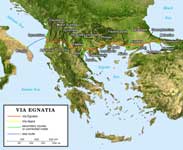.

Via Egnatia (Greek: Εγνατία Οδός) was a road constructed by the Romans around 146 BC. It was named after Gnaeus Egnatius, proconsul of Macedonia, who ordered its construction. The road stretched across Illyria, Macedonia, and Thrace, running across modern Albania, FYROM (Former Yugoslav Republic of Macedonia), Greece, and Turkey. It was constructed in order to link up different Roman colonies from the Adriatic Sea to Byzantium.
The Via Egnatia was repaired and expanded several times. It remained an important commercial and strategic route for centuries, and was one of the most important roads in the Byzantine Empire, connecting Dyrrhachium (present-day Durrës) on the Adriatic with Lychnidos (Ohrid), Thessalonica (Thessaloniki), Perinthus (later Heraclea), and finally Constantinople (Istanbul) on the Bosporus. Almost all Byzantine overland trade with western Europe travelled along the Via Egnatia. During the Crusades, armies travelling to the east by land followed the road to Constantinople before crossing into Asia Minor. In the aftermath of the Fourth Crusade, control of the road was vital for the survival of the Latin Empire as well as the Byzantine successor states the Empire of Nicaea and the Despotate of Epirus.
Egnatia Odos (Modern highway)
In the 1990s, construction began on a modern Egnatia in Greece, also known as National Road 2 or Egnatia Odos (Εγνατία Οδός). The new highway, with a total length of 670 km, (currently 66% complete) begins at the Greek-Turkish border on the Evros river and, after 76 tunnels of 99 km combined length and 1650 bridges, ends at the western Greek port of Igoumenitsa, which is connected to the ports of Brindisi, Bari, Ancona and Venice, Italy by ferry boats. It is a closed highway with sophisticated electronic surveillance measures, SCADA controls for the lighting/tunner ventilation and advanced vehicle collision absorption measures.
From Evros to Thessaloniki, the new highway closely parallels the ancient route, sometimes even coinciding with it. This is largely finished now (except for the Nestos Bridge). The other part of the highway, from Thessaloniki to Ioannina is largely unfinished, but work is due to completition. This is the most challenging part, and perhaps the greatest construction ever undertaken in modern Greece, as it is designed to traverse the mountainous regions of Macedonia and Epirus. In mid-2005, the critical Polymylos-Kastania segment was delivered. This segment literally goes trough the Vermion mountains and features numerous tunnels and deep bridges, connecting Thessaloniki to Kozani. Similar works on the Pindos range (i.e. from Grevena to Ioannina) were delayed due to environmental concerns about the destruction of the habitat of the endangered brown bear. However, a new routing was proposed in 2003, and now this part is expected to be complete in 2008.
In addittion to the main highway, three perpendicular auxiliary highways are under construction connecting the highway to important cities, ports and airports of Macedonia.
The whole project is estimated to cost about 5.9 billion euros while it will be completed in 2009 and probably is the most ambitious and expensive public works ever taken place in modern Greece. Its international designation is E90.
Links
- http://www.viaegnatia.net/pdf/inglese.pdf
- Michele Fasolo: La via Egnatia I. Da Apollonia e Dyrrachium ad Herakleia Lynkestidos, Roma, 2005, 2nd ed.
- HiT.gr - Via Egnatia 2004 - A small video sequence of the official opening of the Via Egnatia in Thesprotia (December 2004)
- www.egnatia.gr - The official website, with information on current progress and more.
|
Roads in Greece GR-1 | GR-2 | GR-3 | GR-4 | GR-5 | GR-6 | GR-7 | GR-8 | GR-8A | GR-9 | GR-9A | GR-12 | GR-13 | GR-14 | GR-15 | GR-16 | GR-18 | GR-20 | GR-21 | GR-22 | GR-26 | GR-27 | GR-30 | GR-31 | GR-33 | GR-38 | GR-39 | GR-42 | GR-44 | GR-48 | GR-50 | GR-51 | GR-51 | GR-57 | GR-65 | GR-66 | GR-67 | GR-70 | GR-74 | GR-76 | GR-77 | |
| Ancient Greece
Science, Technology , Medicine , Warfare, , Biographies , Life , Cities/Places/Maps , Arts , Literature , Philosophy ,Olympics, Mythology , History , Images Medieval Greece / Byzantine Empire Science, Technology, Arts, , Warfare , Literature, Biographies, Icons, History Modern Greece Cities, Islands, Regions, Fauna/Flora ,Biographies , History , Warfare, Science/Technology, Literature, Music , Arts , Film/Actors , Sport , Fashion --- |
Retrieved from "http://en.wikipedia.org/"
All text is available under the terms of the GNU Free Documentation License



